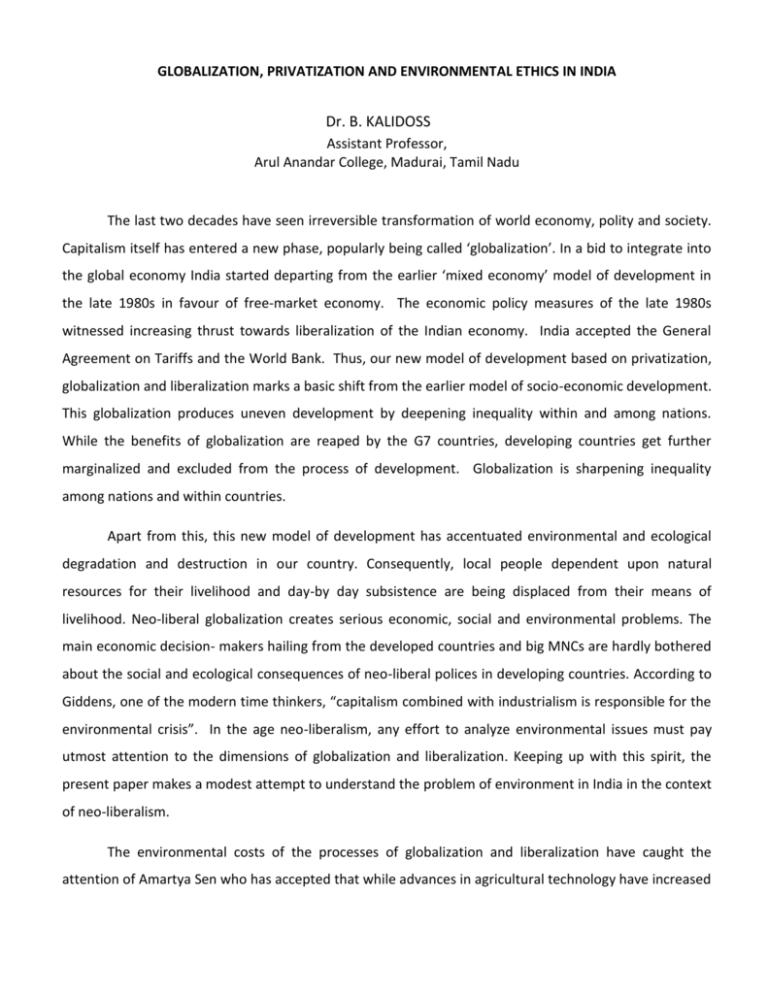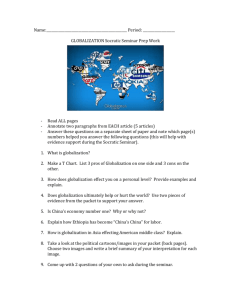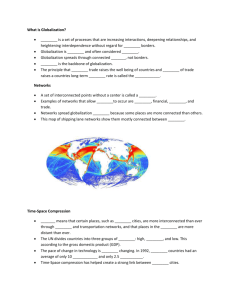environment&globalization
advertisement

GLOBALIZATION, PRIVATIZATION AND ENVIRONMENTAL ETHICS IN INDIA Dr. B. KALIDOSS Assistant Professor, Arul Anandar College, Madurai, Tamil Nadu The last two decades have seen irreversible transformation of world economy, polity and society. Capitalism itself has entered a new phase, popularly being called ‘globalization’. In a bid to integrate into the global economy India started departing from the earlier ‘mixed economy’ model of development in the late 1980s in favour of free-market economy. The economic policy measures of the late 1980s witnessed increasing thrust towards liberalization of the Indian economy. India accepted the General Agreement on Tariffs and the World Bank. Thus, our new model of development based on privatization, globalization and liberalization marks a basic shift from the earlier model of socio-economic development. This globalization produces uneven development by deepening inequality within and among nations. While the benefits of globalization are reaped by the G7 countries, developing countries get further marginalized and excluded from the process of development. Globalization is sharpening inequality among nations and within countries. Apart from this, this new model of development has accentuated environmental and ecological degradation and destruction in our country. Consequently, local people dependent upon natural resources for their livelihood and day-by day subsistence are being displaced from their means of livelihood. Neo-liberal globalization creates serious economic, social and environmental problems. The main economic decision- makers hailing from the developed countries and big MNCs are hardly bothered about the social and ecological consequences of neo-liberal polices in developing countries. According to Giddens, one of the modern time thinkers, “capitalism combined with industrialism is responsible for the environmental crisis”. In the age neo-liberalism, any effort to analyze environmental issues must pay utmost attention to the dimensions of globalization and liberalization. Keeping up with this spirit, the present paper makes a modest attempt to understand the problem of environment in India in the context of neo-liberalism. The environmental costs of the processes of globalization and liberalization have caught the attention of Amartya Sen who has accepted that while advances in agricultural technology have increased the potential for improving living conditions in the rural areas, environmental degradation poses a serious threat to the livelihood of the rural population in many countries. In India no political leader is sufficiently interested to ensure that the emerging global market or the emerging ecological policy is managed in the principles of ‘good governance’. Environment hardly figures on the agenda of our political parties, and the statements of our policy makers or environment are paradoxical and contradictory. Environmentalists like M.C.Mehta Patkar, Anil Agarwal and Sunita Narain have repeatedly empahsised the necessity of including environmental issues in election manifestos. According to Narain, environmental diplomacy has turned into petty business transactions built on principles systems that are based on the principles of democracy, justice and equality. Desai has also argued that the Indian State is at its weakest today, paralysed by trivial political differences. According to him, the combination of weak state and an emaciated private sector is proving to be lethal. No section of our ruling elite seems to care about the national interest and India has reached a virtual dead end. But late Anil Agarwal talked about four rays of hope despite dismal scenario with regard to environment. They are: India’s NGO movement, the role of judiciary in environmental protection, ordinary people’s initiatives represented by Sukhomajri and Ralegan Siddhi, and media’s support to environmental concerns. He called for the second war of independence by the post-independence Indians, to be fought with them, to protect their environment, society, culture. Ramachandra Guha, one of the most outstanding scholar, term the period from August 1947 to the early 1970s an age of ecological innocence in which environmental concerns were relegated to the background, given the urge to industrialize rapidly and catch up with the developed world. For Guha, the problem of environment is more alarming than the Kashmir problem. Projects in the Western Ghats India is recognized as one of the 12 ‘mega centers of biodiversity’ in the world. Sanction of development projects in ecologically fragile and bio-diversity rich areas and wanton deforestation are resulting in depletion of our rich biodiversity. The Western Ghats figure among 10 top ‘hot spots’ of biodiversity in the world. It is estimated that over 75,000 species of fauna and 45,000 of flora are found in India. Of the estimated 45,000 plant species, about 15,000 species of flowering plants are endemic to India. The 75,000 species of animals include reptiles, insects and birds. There are 75,000 species used as medicinal plants. 75% health care needs in India are still based on the traditional system based on the use of medicinal plants. However, the region is undergoing rapid industrialization in the wake of liberalization. The development projects which are coming up pose a threat to the ecology of the region. Projects like Mistry Valley Triveni Resrots and Environ Farms are taking shape in the region. Deforestation and Displacement Clearing of forests for commercial purposes and displacement of local communities from their dwellings and livelihood, particularly tribal are on increase. Local communities, mainly tribal, are worst hit as they have evolved a way of life which is entered around natural resources and common property resources. According to an estimate, at least 213 lakh tribal have been displaced as otherwise deprived of their livelihood by projects like dams, mines, industries, national parks and sanctuaries and other projects. Less than a quarter of the displaced persons have been resettled even partially. Bruce Rich estimates that the number of people uprooted by the World Bank sponsored development projects in India since Independence at more than 20 million. According to The State of Forest Report, released by the Forest Survey of India, our country lost a net of 5,482 sq km of forest cover since 1995. This official version of the loss of forests is contrasted by social activists. According to them, the actual loss of dense forest cover is as much as 17,777 sq km. Andhra Pradesh and Madhya Pradesh top the list. The consequences of the loss dense forest are devastating. It adversely affects the availability of groundwater and leads to climatic changes in the long run and depletion of our rich biodiversity. According to the National Forest Policy 1988, the country’s hill districts should each have at least two-thirds of their area under forests. According to an estimate, no norm is followed. The all-India average of forest cover is around 19 percent as against 36 percentages. The Ministry of Environment and Forests has conceded that in the wake of the recent liberalization of the Indian economy, state governments, in their eagerness to invite investments, have been sanctioning projects without considering their impact of the environment or forests. It is estimated, ‘…. Currently there is an annual diversion of about 16,000 hectares of forest land for non-forest-related purposes. There is a constant degradation of dense forests in our country. In the early 1973, te local peasantry of Mandal, a village in the Garhwal Himalaya, protested against state forest policies, which had favoured private interests at the cost of their subsistence needs, by ‘hugging the trees’. This came to be known as ‘Chipco (Hug the Trees) movement. Air Pollution The Economic Survey of the Government of India boasts that delicensing of the automobile industry in the wake of adoption of liberalization led to a boom in investment in automobile industry for producing new cars. Many biggest international players in this field have entered into joint ventures, including General Motors, Mercedes, Daewoo and Hundai. They record a jump in vehicular sales. But The Economic Survey hardly pays any attention to the fact that the post-liberalization phase has also seen quantum of leap in pollution levels, primarily caused by more than 1 lakh new vehicles which get added to our streets every year. One of the ugliest impacts of economic liberalization is the increasing dependence on private motorized transport in cities. In 1996, the Delhi based NGO, the centre for science and environment came out with a report ‘Slow Murder’. It released statistics regarding the number of premature deaths and illness caused in 36 Indian cities by air pollutant associated with vehicular emissions and smoke. Accoding to this report, ‘almost 52,000 people had died in 1995 from pollution – related complications in 63 cities in India against 40,000 in 1991.The number of illness as a result of pollution and which require hospitalization has increased to 26 million for 19 million during the same period. The monetary loss due to deaths works out to Rs.4,500 crores a year, and on account of medical treatment Rs.160 crores. Human rights watchdog Amnesty International on Tuesday alleged that the government and Vedanta had failed to protect Orissa’s indigenous communities from health hazards of mining. Amnesty alleged that the 8,000 strong community, mainly ‘adivasis’ (tribals) in Orissa’s Lanjigarh suffered violations of human rights to water and health, due to pollution by Vedanta’s aluminium refinery. “Vedanta Aluminium Ltd’s alumina refinery has led to water and air pollution, seriously undermining the quality of life and threatening the health of nearby communities, some of whom live only a few hundred yards from the refinery’s boundary walls,” the Amnesty report said. It also alleged that the Centre failed to obtain “free, prior and informed consent” of the Dongria Kondh people living in forests of Niyamgiri Hills before approving this project. Water Pollution WHO pointed out that 80 percentage of deaths in India were caused by water-related diseases. The quality of water is further detoriating with dumping of waste rise in pollution and rapid industrialization. Scientists at the National Environment Engineering and Research Institute, Nagpur has concluded that 70 percent of the available water in India is polluted. The fresh water crisis is looming large over India. Water is used as political and economical tool, controlled and cornered by the rich, who do not pay the price for this scarce resource. One report warns us that India will be a ‘water-stressed’ nation by 2017. Coca-Cola Company is perhaps the most widely recognized corporate symbol on the planet. In India, Coca-Cola destroys local agriculture by privatizing the country’s water resources. In Plachimada, Kerala, Coca-Cola extracted 1.5 million liters of deep well water, which they bottled and sold under the names Dasani and Bon Aqua. The groundwater was severely depleted, affecting thousands of communities with water shortages and destroying agricultural activity. As a result, the remaining water became contaminated with high chloride and bacteria levels, leading to scabs, eye problems, and stomach aches in the local population. The company also leads in the abuse of workers’ rights, assassinations, water privatization, and worker discrimination. Between 1989 and 2002, eight union leaders from Coca-Cola bottling plants in Colombia were killed after protesting the company's labor practices. Hundreds of other Coca-Cola workers who have joined or considered joining the Colombian union SINALTRAINAL have been kidnapped, tortured, and detained by paramilitaries who are hired to intimidate workers to prevent them from unionizing. GM SEED GM crops have an impact on health and environment. Monsanto is, by far, the largest producer of genetically engineered seeds in the world, dominating 70% to 100% of the market for crops such as soy, cotton, wheat and corn. Monsanto is the world’s leading producer of the herbicide glyphosate, marketed as Roundup. Roundup is sold to small farmers as a pesticide, yet harms crops in the long run as the toxins accumulate in the soil. Plants eventually become infertile, forcing farmers to purchase genetically modified Roundup Ready Seed, a seed that resists the herbicide. This creates a cycle of dependency on Monsanto for both the weed killer and the only seed that can resist it. Both products are patented, and sold at inflated prices. Exposure to the pesticide is documented to cause cancers, skin disorders, spontaneous abortions, premature births, and damage to the gastrointestinal and nervous systems. According to the India Committee of the Netherlands and the International Labor Rights Fund, Monsanto also employs child labor. In India, an estimated 12,375 children work in cottonseed production for farmers paid by Indian and multinational seed companies, including Monsanto. Andhra Pradesh has some of the most vociferous critics of GM crops and also is one of the states in India that has seen a lot of protests by farmers and social groups. A number of suicides in Andhra Pradesh have been by farmers of Bt Cotton. The farmers of Karnataka and Andhra Pradesh have expressed strong apprehensions about the long term harmful effects of genetically engineered seeds, for example, pest tolerant Bollgard TM (Bt ) Cotton, produced by the US multinational Monsanto. The controversial technology allegedly involves introduction of a gene that terminates germination capacity of seeds after one-time use. The farmers apprehend that this will force them to buy seeds from MNCs for each crop. At least now the government needs to act and impose a complete ban on open field trials not only in Andhra Pradesh but all over the country. If we continue to give in to the multinational companies we will not only lose our seed sovereignty but also put the lives of lakhs of farmers at their mercy.” There is a great need to have a scientific enquiry, restructure the regulatory system so that there is accountability and put a complete ban on field trials across the country. If we were to see the statistics, a 70 per cent increase in yield happened in 2004-05 and the Bt cotton accounted for just 6.5 per cent and by 2009-10, the area of Bt cotton increased by 85 per cent but the increase in yield was only 2 per cent.” India is bestowed with diversity of crops and we have natural repellants. Bacteria are available in the soil. Naturally available bacteria should not be disturbed. Unlike in western countries where there is mono culture, we don’t need GM crops at all. We are just playing into the hands of multinational companies. D’Souza argues that the entire biotechnology revolution, with all its potentially dangerous ecological consequences, is essentially the projection of the image of capital into seed production. While the benefits of globalization are reaped by the seeds and chemical corporations, the cost and risks are exclusively born by the small farmers and landless peasantry. So we need strong state regulation for the commercial private seed supply and strong community control and public participation with regard to farmer seed supply. Dumping of toxic waste In the wake of liberalization, the GoI has allowed import of toxic waste on a large scale. It is argued that it will promote industrialization. The post-liberalization is marked import of hazardous wastes to India by several countries. These imports run into millions of kilograms of highly toxic chemicals, metal, plastic waste. Our government has adopted a myopic attitude towards the dangers of toxic trade. Our country’s trade with developed nations in recyclable toxic waste has been increasing. This inflow of toxic waste into our country poses a serious threat to our ecology and public health. The rich countries want to keep their environment clean by disposing of such waste to developing countries whose recycling is banned there. There is lack of awareness in the developing countries about the hazards of toxic waste. The companies import these wastes for recycling business in order to make money. But profits of thousands of crores of rupees will put lives of many thousand innocent people in jeopardy. It is another Bhopal in the making. According to an estimate, ‘as much as 90 percentage of the waste generated in developed countries is exported to the third world countries like India, for the simple reason that disposing of these material anywhere in their country would cost the earth- disposing of a tone of zinc waste would cost 5,000 American dollar in the USA, whereas the same west sells for 150 dollar a tone in the third world. Since pollution control norms are stringent in the west, industries find it expensive to dispose of their wastes within their borders. It is easier and less expensive for them to ship their wastes to India where pollution control norms are weak. Our country cannot be made a dumping ground toxic waste generated by developed countries. Dow Chemical has been destroying lives and poisoning the planet for decades. In 2001, Dow inherited the toxic legacy of the worst peacetime chemical disaster in history when it acquired Union Carbide Corporation (UCC) and its outstanding liabilities in Bhopal, India. On Dec. 3, 1984, a chemical leak from a UCC pesticide plant in Bhopal gassed thousands of people to death and left more than 150,000 disabled or dying. Dow still refuses to address its liabilities in Bhopal. Conclusion Certainly, India cannot opt out of the process of globalization and go back to old mixed economy model of development. In fact, no region or no part of world can remain as an isolated island in the era of globalization. The government should take measures on its own to redirect the process of economic reforms in favour of the poor disadvantaged and environment friendly. Only time will tell us to what extent the poorest and most deprived people of our society, as of world society in general and third world society in particular, are able to turn the current tide of globalization and liberalization in their favour. Challenge to the current forces of globalization and liberalization has come at various levels – local, national and global. Works Cited D’Souza, Rohan, Capitalism’s Ecological Crisis”, Seminar, No 516, August2002. Gadgil, Madhav and Guha Ramachandra. Ecology and Equity: The Use of Abuse of Nature in Contemporary India. London: Routledge, 1995. Giddens, Anthony. The Consequences of Modernity, Cambridge: Polity Press, 1990. Narain, Sunita, “Changing Environmentalism”, Seminar, No.516, August 2002. Poddar, Ganeshdatta. Globalization, Liberalization and Environmentalism. Jaipur: Rawat Publications, 2009. Rich, Bruce, Mortgaging The Earth: The World Bank, Environmental Impoverishment, and the Crisis of Development. Boston: Beacon Press, 1994. CURRICULUM VITAE PERSONAL PROFILE: Name: Designation: Date of Birth: Contact Address: Dr. B.KALIDOSS, M.A., M.Phil., Ph.D. Assistant Professor of English 02.07.1970 49, Indirani Nagar, II nd Street Mudakkusalai, Madurai, pin-625016 Mobile No: 9489379319 Email: dossjishnu@gamail.com EDUCATIONAL QUALIFICATION: Degree University/Institution Ph.D Manonmaniam Sundaranar University, Tirunelveli M.Phil. Madurai Kamaraj University, Madurai (DDE) M.A Madurai Kamaraj University, Madurai B.A Devanga Arts College, Aruppukottai Subjects Year of passing Indian Writing in English 013 Translation 2006 English & Comparative Literature 1994 English Literature 1990 ACADEMIC EXPERIENCE: 18 years and 4 months SEMINARS/CONFERENCES: National Conference/Seminar International Conference 18 02 Workshop 04 Total 24 PUBLICATIONS: International Journals: Kalidoss.B, “Cross-cultural Confrontations in Bharati Mukherjee’s Wife”, Tjells, Vol:1, Issue: iii, October-December, ISSN: 2249-2151 Kalidoss.B, “The Psychic Patterns in Bharati Mukherjee’s Wife”, Indian Journal of Applied Research, Vol:1, Issue:8, May 2012, ISSN: 2249-55X. CONTRIBUTIONS TO BOOKS: Dr. Kalidoss.B, “Water Management in India”, Managing for Tomorrow - Emerging Issues and Challenges, Shanlax Publications, 2014, ISBN 978-93-80657-29-5 Trends, Dr. Kalidoss.B, “Racial Violence in Richard Wright’s Black Boy,” Trends in Alterative Literature, Vergal Publication, 2014, ISBN 978-81-928113- 9-0 Dr. Kalidoss.B & A.Vigneshkumar, “A Film Review of Deepa Mehta’s Fire Lesbianism: A Liberation From the Patriarchal Society, Feminism Today, Vergal Publication, 2014,(ISBN:97881-92811388-7) Dr. Kalidoss.B, “Trauma and Triumph: A Study of Bharati Mukherjee’s Jasmine, Transpiring Trends in English Language and Literature, Department of English, N.M.S.S. Vellaichamy Nadar College, Madurai, 2014, (ISBN:978-93-84-1310-1-7) Kalidoss.B, “Teaching English Through Literature to ESL Students”, English Language Teaching And Learning – Trends and Techniques, 2014, (ISBN:978-81-924922-9-2) Kalidoss.B, “The Tiger’s Daughter – Identity in Exile,” New Vistas in Indian Writing in English, Research Centre, VHNSN College, 2012, (ISBN:978-93-81723-09-8) Kalidoss.B, “Immigrant Lives: The Protagonists in Bharati Mukherjee’s Jasmine and Wife” English Language and Literature: Across Cultures, Vol: II, The Department of English, St. Johan’s College Tirunelveli, 2012. (ISBN – 978-81-923897-0-7) Dr. B. Kalidoss Assistant Professor of English Arul Anandar College Madurai, Tamil Nadu To The Editor in Chief New Man Publication Narwadi, Dist. Parbhani - 431516 Sir Sub: Publication of an article - reg I herewith send my paper entitled “GLOBALIZATION, PRIVATIZATION AND ENVIRONMENTAL ETHICS IN INDIA” to be published in the forthcoming issue. I assure you that this paper is my original contribution and has not been plagiarized/copied from any source/ individual. This paper has not been previously published elsewhere. I request you to publish this article in your esteemed journal. Thanking you, Date: 23.01.2015 Truly Dr. B.Kalidoss







